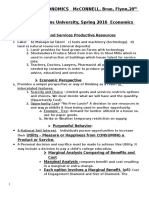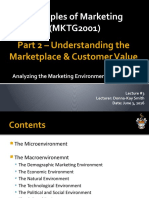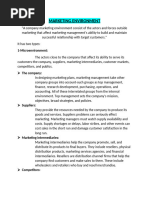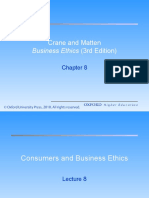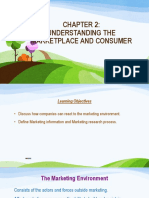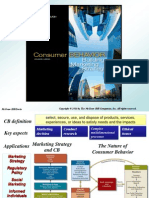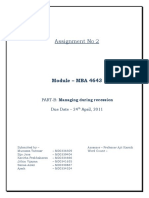0 ratings0% found this document useful (0 votes)
48 viewsUnderstanding The Macro and Micro Environment: See Past Exam Papers For Sample Questions
Understanding The Macro and Micro Environment: See Past Exam Papers For Sample Questions
Uploaded by
1shreyaThe document discusses the macro and micro environmental factors that influence marketing. It covers topics like competitive environment, political-legal factors, economic conditions, technology, socio-cultural influences, and natural forces. It also examines consumer and industrial buyer behavior and analyzing competitive forces.
Copyright:
© All Rights Reserved
Available Formats
Download as PPT, PDF, TXT or read online from Scribd
Understanding The Macro and Micro Environment: See Past Exam Papers For Sample Questions
Understanding The Macro and Micro Environment: See Past Exam Papers For Sample Questions
Uploaded by
1shreya0 ratings0% found this document useful (0 votes)
48 views36 pagesThe document discusses the macro and micro environmental factors that influence marketing. It covers topics like competitive environment, political-legal factors, economic conditions, technology, socio-cultural influences, and natural forces. It also examines consumer and industrial buyer behavior and analyzing competitive forces.
Original Description:
its about principles of marketing fundamental
Original Title
Marketing Principles 0310 1
Copyright
© © All Rights Reserved
Available Formats
PPT, PDF, TXT or read online from Scribd
Share this document
Did you find this document useful?
Is this content inappropriate?
The document discusses the macro and micro environmental factors that influence marketing. It covers topics like competitive environment, political-legal factors, economic conditions, technology, socio-cultural influences, and natural forces. It also examines consumer and industrial buyer behavior and analyzing competitive forces.
Copyright:
© All Rights Reserved
Available Formats
Download as PPT, PDF, TXT or read online from Scribd
Download as ppt, pdf, or txt
0 ratings0% found this document useful (0 votes)
48 views36 pagesUnderstanding The Macro and Micro Environment: See Past Exam Papers For Sample Questions
Understanding The Macro and Micro Environment: See Past Exam Papers For Sample Questions
Uploaded by
1shreyaThe document discusses the macro and micro environmental factors that influence marketing. It covers topics like competitive environment, political-legal factors, economic conditions, technology, socio-cultural influences, and natural forces. It also examines consumer and industrial buyer behavior and analyzing competitive forces.
Copyright:
© All Rights Reserved
Available Formats
Download as PPT, PDF, TXT or read online from Scribd
Download as ppt, pdf, or txt
You are on page 1of 36
Understanding the Macro
and Micro Environment
See Past Exam Papers for Sample
Questions
1 of 36
Learning outcomes
Elements of the marketing environment
Macro and Micro environmental analysis
Understanding Consumer Buyer
Behaviour
Understanding Industrial Buyer Behaviour
Defining and analysing competitive forces
The Macro
Marketing
Environment
Copyright: Southwestern
Publications 2006
1. The Competitive Environment
Competitive Environment:
competitive products, substitute
products for one another, companies
competing for your consumers
purchasing power.
Monopoly examples in Ireland?
Deregulation movement - ex
Oligopoly - ex
Direct
Competitive
Products
Which would you
buy?
Indirectly Competitive Products
products than can be substituted for
one another
Plastic Containers vs. Glass vs. Tin vs.
Aluminum
Sugar vs. Artificial Sweeteners
Typewriter vs. PC
Ocean Liner Vs. Air Travel
Developing a Competitive
Strategy
Should we compete?
If so, in what markets should we
compete?
How should we compete?
Involves:
Researching the market
Identifying current &potential
competitors
Anticipating competitive actions
2. Political-Legal Environment
Component of the marketing
environment consisting of laws and
interpretations of laws that require
firms to operate under competitive
conditions and to protect consumer
rights.
Deregulation
Increases
Competitiveness
Regulatory Forces
Government :
Consumer Safety
Commission, IFSRA,
Environmental
Protection Agency,
Health and Safety etc
Consumer interest
groups
PETA
Special-interest groups
ISME
Self-regulatory groups
Advertising
Companies fight
unjust regulations
Regulations can
present new
opportunities
Political lobbying
Boycotts
Political action
committees
Controlling the PL
Environment
Is Horticulture industry regulated?
10 of 36
3. The Economic Environment
Factors influencing consumer buying
power and strategies (stage of the
business cycle, inflation,
unemployment, resources, income
etc)
The Wealth effect
(Ireland)
The figures on the map show the level of
average new car prices in each market
compared to the average for all euro currency
markets. Index 100 represents the European
average
Source: Fact
Finders 2006
Fastest Growing Market for
New Car Eastern Europe
(Latvia 49% increase on 2005)
During prosperous times car
manufacturers will add luxury
extras
The Wealth
Effect
Inflation and Deflation
Inflation: The devaluation of money by
reducing what it can buy through
continued price increases. (Ireland)
Deflation: Falling prices
* Lowest annual EU rates: Netherlands
(3.0%/1.9%), Portugal (3.1%/-1.2%), Ireland
(3%/-2.4%). Highest rates: Latvia (15.6%/7.7%),
Lithuania (12.2%/6.9%).
Unemployment
The proportion
of people in
the economy
who do not
have jobs and
are actively
looking for
work.
Income
Discretionary income: the amount of
money people have to spend after
paying bills and necessities.
Resource Availability
Demarketing: reducing consumer
demand for a good or service to a level
that the firm can supply.
4. The Technological Environment
The technological
environment:
application of
knowledge in
science,
inventions, and
innovations to
solve problems
Toyota Prius
Heating
Technologies
Technology Advances Consumer Needs
Technology increases exponentially
New technology as a key to long-term
competitive advantage
create more efficient operation or better
products
may render existing products obsolete
6
5. The Social-Cultural Environment
The relationship
between marketing
and society and its
culture
Issues:
Obesity in
Children
Negative Body
Images
Video Games
Healthy Eating
etc ..
Cultural Environment: Elements of
Culture
1. Language
2. Manners & Customs
3. Technology & Material Culture
4. Social Institutions business, family,
political- Latin America
5. Education transmitting values, skills,
attitudes etc
6. Aesthetics attitude toward beauty, art,
music etc
7. Religion
20 of 36
Worlds Religions
Christianity - 2.0 billion followers
Islam - 1.2 billion followers
Hinduism - 860 million followers
Buddhism - 360 million followers
Confucianism - 150 million followers
Religion can affect marketing strategy
Social Environment: Role of
Families and Working Women
Working women has had a greater effect
on marketing than any other social change
Increases in females in the workforce
Purchasing power from dual-career
families
is rising
Cost is more important to women.
Quality is more important to men.
2
Population Considerations
Concerned with the study of the quantifiable
aspects of population structures,e.g., age,
gender, size, race, occupation and location.
Some factors to consider:
falling birth-rates
the rise of the mature market segment
the household of one
Demographic Factors
3
Generation Y: Born between 1979 and
1994, size = marketing impact, fickle and
skeptical group, technos
Generation X: Born between 1965 and
1978, time premium, majority have
children and houses, savvy and cynical
consumers
Baby Boomers: Born between 1946 and
1964
Younger Boomers (ages 41 to 49)
Home is the castle, spend on kids
Older Boomers (ages 50 to 59)
Spend on home upgrades & Holidays
Growing Ethnic and Community
Markets
Irish population is becoming multicultural
society and workforce
Growth in spending power in:
Eastern European Populations
African Populations
Asian Populations
4
Pink
Pound -
Dorothy
Dollar
6. Natural Forces
Conserve natural habitats,
resources, endangered species
Minimise environmental impact
Sustainable resource use
Recycle
Energy efficient products
The Polluter Pays Principle
The Micro Environment
Customers: needs, wants and providing benefits for
their customers. Failure = failed business strategy.
Employees: correct and motivated staff is essential to
strategic planning. Training and development, service
sector, competitive edge. (Cereality)
Suppliers: Price of raw material affect the marketing
mix. Closer supplier relationships benefit strategy.
Shareholders: inward investment for growth.
Satisfying shareholder needs can cause a change in
strategy. (Sharwoods+internet companies, Birds Eye)
Media: Positive or adverse attention. Consumer
programs
Consumer Buyer Behaviour
Chapter 5 of book
Talk about 3 consumer roles Consumer is a
user, a payer and a buyer;
User concerned about product features and the
uses they can be put to (JML ads on TV)
Payer concerned about price and credit deals
available (0% down, 0% until)
Buyers concerned with logistics of procuring the
product (order by certain date for delivery
before)
Consumer Buyer Behaviour
Consumer Needs & Wants
Needs are unsatisfactory conditions of the
consumer that prompt them to an action that will
make the condition better
Wants are desires to obtain more satisfaction
than is absolutely necessary
Food vs. Gourmet Food, Car vs. Porsche etc
Consumer Behaviour-Psychology
The perception of a consumer about a certain
service/product is what matters.
Learning also features in consumer behaviour.
Especially for a complex purchase.
Motivation is defined as a state of drive that
impels behaviour towards a goal-object.
30 of 36
Maslows Hierarchy of Needs
Abraham Maslow described motivation as a
means of satisfying human needs.
1. Physiological Needs Food, shelter
2. Safety & Security Needs car safety, fire safety
3. Belongingness & Love Needs Teenagers clothes
4. Esteem & Ego Needs Self Gift Giving
5. Need for Self Actualization Engage in self
improvement activities
Psychographics:Describing Consumer
Behaviour
Psychographics is a facet of motivation and
explains how a person acts during the
consumption phase.
The way they act is guided by a persons:
Values
Self Concept
Lifestyle
VALS values & Lifestyles
Attitudes
Individual Consumer Decision Making process
Step 1: Problem Recognition
Step 2: Information Search
Step 3: Alternative Evaluation
Step 4: Purchase
Step 5: Post purchase Experience
Chap 5 of Book
Industrial Buyer Behaviour
Who says that you will always market to an
individual??
The decision-making process by which formal
organisations establish the need for purchased
products and services, and identify, evaluate, and
choose among alternative brands and suppliers
Kotler and Armstrong 1989
Industrial Buyer Behaviour
The process can be summarised as follows
- Problem Recognition
- Need Description
- Product Specification
- Supplier Search
- Supplier Selection
- Purchase Routine Specification
- Performance Review
Analyzing Competitive Forces
Check Chapter 4 of Book, from pg 117
Competitor Research
Auditing Current Competitors
Auditing Potential New Competitors
See in chapter 4 a competitor Analysis Template
You might also like
- Macroeconomics Mcconnell Chapter 1-13b 20th UpdatedDocument52 pagesMacroeconomics Mcconnell Chapter 1-13b 20th UpdatedSamiha Antara100% (1)
- Case Study The Body ShopDocument21 pagesCase Study The Body ShopBridgestone55100% (1)
- Understanding The Macro and Micro Environment: See Past Exam Papers For Sample QuestionsDocument36 pagesUnderstanding The Macro and Micro Environment: See Past Exam Papers For Sample QuestionsRadu MirceaNo ratings yet
- 7410 - Rangkuman PPT Marketing ManagementDocument6 pages7410 - Rangkuman PPT Marketing ManagementMuhammad IhsanNo ratings yet
- Session 3Document7 pagesSession 3lison.deleuNo ratings yet
- Marketing EnvironmentDocument7 pagesMarketing Environmentbetsyalton8No ratings yet
- International Marketing Long PDFDocument3 pagesInternational Marketing Long PDFRalph R. VillanuevaNo ratings yet
- Chapter 5Document19 pagesChapter 5Edrees RahimiNo ratings yet
- Marketing Management Chapter 4Document33 pagesMarketing Management Chapter 4Ahasanul ArefinNo ratings yet
- Module 1 Marketing Overview & Business EnvironmentDocument9 pagesModule 1 Marketing Overview & Business EnvironmentnicaapcinaNo ratings yet
- Chapter 3, 8Document5 pagesChapter 3, 8captainfoodproductNo ratings yet
- Chapter 3Document8 pagesChapter 3karolfontanellaNo ratings yet
- Environmental ScanningDocument30 pagesEnvironmental ScanningMuhammad ZeeshanNo ratings yet
- Marketing Environment) : ChapterDocument15 pagesMarketing Environment) : Chapteraye ayeNo ratings yet
- Class Notes - The Marketing EnvironmentDocument6 pagesClass Notes - The Marketing EnvironmentDuval Pearson89% (9)
- 2016.06.3 - Lecture 3 - Principles of Marketing - Chapter 3Document39 pages2016.06.3 - Lecture 3 - Principles of Marketing - Chapter 3nipoNo ratings yet
- Marketing EnvironmentDocument7 pagesMarketing Environmentsaadrana7867No ratings yet
- NotesDocument7 pagesNotesIam neuroticghorlNo ratings yet
- Reference Material For Students (Environment Studies) : Foundation-Design/TechnologyDocument45 pagesReference Material For Students (Environment Studies) : Foundation-Design/TechnologyOjasvee KashyapNo ratings yet
- Marketing Environment 1Document23 pagesMarketing Environment 1vishal111089No ratings yet
- New Issues in MarketingDocument20 pagesNew Issues in MarketingSaurav ThakurNo ratings yet
- Chapter 3 PowerPoint---Principles of MarketingDocument23 pagesChapter 3 PowerPoint---Principles of Marketinghamzahindawi06No ratings yet
- NESTLEDocument4 pagesNESTLEReza MuhammadNo ratings yet
- Crane and Matten: Business Ethics (3rd Edition)Document29 pagesCrane and Matten: Business Ethics (3rd Edition)Usama RahmanNo ratings yet
- Craneandmatten3e ch08Document29 pagesCraneandmatten3e ch08Sadaf TasneemNo ratings yet
- Lecture 3 - Market Environmental AnalysisDocument35 pagesLecture 3 - Market Environmental AnalysisHương Ly LêNo ratings yet
- Sustainability, Ethics and Social Responsibility MarketingDocument13 pagesSustainability, Ethics and Social Responsibility MarketingAkash RanjanNo ratings yet
- Lecture 5Document28 pagesLecture 5ZHM IbrahimNo ratings yet
- Chapter 3Document21 pagesChapter 3Aman UllahNo ratings yet
- The Marketing EnvironmentDocument21 pagesThe Marketing EnvironmentIMRAN ALAM100% (1)
- Chapter 2 Understanding The Marketplace and ConsumerDocument33 pagesChapter 2 Understanding The Marketplace and Consumerizza mardhia abdul rahmanNo ratings yet
- BUS 5112 - Marketing Management-Portfolio Activity Unit 7Document6 pagesBUS 5112 - Marketing Management-Portfolio Activity Unit 7YoYoNo ratings yet
- Chapter 3 Analyzing The Marketing Environment-Chapter 3 E (A) PDFDocument32 pagesChapter 3 Analyzing The Marketing Environment-Chapter 3 E (A) PDFfkjvkfdkv100% (1)
- BE NotesDocument43 pagesBE NotesPriti TiwariNo ratings yet
- Chapter 3 E28093 Analysing The Market EnvironmentDocument2 pagesChapter 3 E28093 Analysing The Market EnvironmentAbdullah100% (1)
- Prospects and Challenges of Global MarketingDocument7 pagesProspects and Challenges of Global Marketingஸ்ரீ ஹரிஸ்No ratings yet
- Marketing Management SAMPLE PAPER SolutionDocument22 pagesMarketing Management SAMPLE PAPER Solutionanjnaprohike26No ratings yet
- Analyzing The Marketing EnvironmentDocument23 pagesAnalyzing The Marketing EnvironmentSANAD MEHYARNo ratings yet
- Marketing 6th Edition Grewal Solutions Manual 1Document13 pagesMarketing 6th Edition Grewal Solutions Manual 1christina100% (64)
- BM EnablingTaskNo.3Document2 pagesBM EnablingTaskNo.3Nathaniel GeronNo ratings yet
- MarketingDocument1 pageMarketingluckyakNo ratings yet
- CH 2Document34 pagesCH 2kichuubmcNo ratings yet
- DMM - Principles and Practice of MarketingDocument154 pagesDMM - Principles and Practice of MarketingPeter N. GakereNo ratings yet
- MKTG EnviDocument17 pagesMKTG Envijyotiraj_70No ratings yet
- MS3 Midterms 1Document76 pagesMS3 Midterms 1ForkensteinNo ratings yet
- Marketing MyopiaDocument29 pagesMarketing MyopiaMuzammil MuzammilNo ratings yet
- Exploratory ResearchDocument12 pagesExploratory Researchitsmughal003No ratings yet
- Marketing SummaryDocument37 pagesMarketing SummaryLara RivasNo ratings yet
- The Marketing Environment: Prasad T S Mba (PT) II Sem SMS, CusatDocument31 pagesThe Marketing Environment: Prasad T S Mba (PT) II Sem SMS, CusatprasadtsivaNo ratings yet
- Chapter 3Document30 pagesChapter 3JP ONo ratings yet
- Enviornment Analysis in IBDocument35 pagesEnviornment Analysis in IBAbhishek RanwakaNo ratings yet
- MGT 301 PRINCIPLES OF MARKETINGDocument9 pagesMGT 301 PRINCIPLES OF MARKETINGbc240200671zaiNo ratings yet
- Analyzing Marketing EnvironmentDocument9 pagesAnalyzing Marketing Environmentdayu Banda putriNo ratings yet
- Chapter 1 Strategic Marketing ManagementDocument80 pagesChapter 1 Strategic Marketing ManagementRubie CabasagNo ratings yet
- Class2 MBADocument21 pagesClass2 MBAshashankc18No ratings yet
- Lecture 2Document45 pagesLecture 2Mostafa RabieNo ratings yet
- Unit-1 Teaching NotesDocument6 pagesUnit-1 Teaching NotesSandeep KumarNo ratings yet
- CH001Document23 pagesCH001reshkamath11No ratings yet
- Unit 1: Introduction To MarketingDocument94 pagesUnit 1: Introduction To MarketingManjunath ShivannaNo ratings yet
- Marketing Calculator: Measuring and Managing Return on Marketing InvestmentFrom EverandMarketing Calculator: Measuring and Managing Return on Marketing InvestmentNo ratings yet
- The Theory of The Accommodation Based Consumerist Economic System IVFrom EverandThe Theory of The Accommodation Based Consumerist Economic System IVNo ratings yet
- PESTELE Analysis of Hotel BLUDocument15 pagesPESTELE Analysis of Hotel BLUevance gitahiNo ratings yet
- Relationship Between Central Bank and The TreasuryDocument4 pagesRelationship Between Central Bank and The TreasuryGurleen KaurNo ratings yet
- ETF Portfolio Details - Saxo Bank - Balanced Portfolio Description 2013Document8 pagesETF Portfolio Details - Saxo Bank - Balanced Portfolio Description 2013Bruno Dias da CostaNo ratings yet
- MONETARY MATRICES /global MonetarismDocument34 pagesMONETARY MATRICES /global MonetarismSfera AssociationNo ratings yet
- National Income AccountingDocument25 pagesNational Income AccountingAnuska ThapaNo ratings yet
- Hemadri - Luxoticca Eyewear - KaranDocument31 pagesHemadri - Luxoticca Eyewear - KaranKaran HemadriNo ratings yet
- Ficci Report 2011Document21 pagesFicci Report 2011DrNeetu Dubey GuptaNo ratings yet
- Hindu Vocabulary May, Jun, Jul, Aug 2023 PDF CompressedDocument37 pagesHindu Vocabulary May, Jun, Jul, Aug 2023 PDF Compressedsrimanta kumar baradNo ratings yet
- Pham Vo Ninh BinhDocument22 pagesPham Vo Ninh BinhKHOA NGUYEN ANHNo ratings yet
- IL - Gloom, Boom & Doom Report - March 2010Document7 pagesIL - Gloom, Boom & Doom Report - March 2010Lars De KockNo ratings yet
- Assignment No 2: Module - MBA 4643Document26 pagesAssignment No 2: Module - MBA 4643funksoul69No ratings yet
- Selected Questions Chapter 24Document13 pagesSelected Questions Chapter 24Pranta SahaNo ratings yet
- Quantity Theory of MoneyDocument8 pagesQuantity Theory of MoneyKeshab BhusalNo ratings yet
- ME 291 Engineering EconomyDocument8 pagesME 291 Engineering EconomysalmanshahidkhanNo ratings yet
- MARK SCHEME For The June 2004 Question PapersDocument17 pagesMARK SCHEME For The June 2004 Question PapersDilshan JayawardanaNo ratings yet
- Nestle Strategic Plan Final Project 4M1 Group. (Major - Marekting)Document50 pagesNestle Strategic Plan Final Project 4M1 Group. (Major - Marekting)mohaNo ratings yet
- 05 May Magazine 2023Document20 pages05 May Magazine 2023Majid AliNo ratings yet
- Application of 10 Principles of Economics in The Real Estate IndustryDocument11 pagesApplication of 10 Principles of Economics in The Real Estate IndustryArminAhsanNo ratings yet
- Unil EverDocument11 pagesUnil EverUtkarsh ChadhaNo ratings yet
- Long-Run Economic Growth: Sources and Policies: Chapter Summary and Learning ObjectivesDocument25 pagesLong-Run Economic Growth: Sources and Policies: Chapter Summary and Learning Objectivesvivianguo23No ratings yet
- ECN 2223d Phillips CurveDocument7 pagesECN 2223d Phillips CurveKanchana Geeth SamaraweeraNo ratings yet
- Economics 1 SyllabusDocument13 pagesEconomics 1 SyllabusWilliam Alexander Matsuhara AlegreNo ratings yet
- Roc ReportDocument6 pagesRoc Reportapi-555390406No ratings yet
- Communication Skills (HU 101) : Courses ObjectivesDocument18 pagesCommunication Skills (HU 101) : Courses ObjectivesSaravanan TkNo ratings yet
- Inflation: "Inflation Is Always and Everywhere A Monetary Phenomenon"Document18 pagesInflation: "Inflation Is Always and Everywhere A Monetary Phenomenon"SafaNo ratings yet
- Course Work SapmDocument9 pagesCourse Work SapmloganathanNo ratings yet
- Egypte Food Drink SurveyDocument71 pagesEgypte Food Drink SurveysaadabdallaNo ratings yet
- Central Superior Services (CSS) Examination, Pakistan - Causes of InflationDocument5 pagesCentral Superior Services (CSS) Examination, Pakistan - Causes of InflationAmeer KhanNo ratings yet
- Measuring and Managing Cost EscalationDocument7 pagesMeasuring and Managing Cost EscalationLeo Caleja100% (1)
